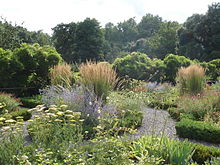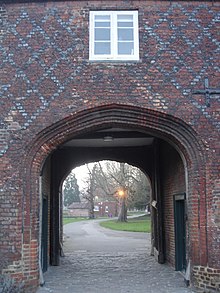Fulham Palace
Fulham Palace is a mansion of medieval origin in the London borough of Fulham (formerly part of the English county of Middlesex ). It was the seat of the Bishop of London from the 11th century until 1975 . It still belongs to the Church of England but is administered by the London Borough of Hammersmith and Fulham and the Fulham Palace Trust . It connects to the Bishop's Park and houses a museum about the history of the mansion and an extensive botanical garden .
history
Origins
During extensive restoration work in 2001-2006, the remains of various earlier large buildings and even evidence of Neolithic and Roman settlements were discovered on the Fulham Palace estate . The settlement on which Fulham Palace stands can date back to around 700 BC. When ownership of the property passed to Bishop Waldher . It belonged to the Bishops of London for over 1300 years and the palace was their country residence from the 11th century at the latest. From the beginning of the 20th century until 1973 it was even their headquarters.
17th century
At the beginning of the 17th century, the gardens at Fulham Palace appear to have received negative attention. The archaeologist John Aubrey lists under his memoranda: "The Bishop of London did cut-down a noble cloud of trees at Fulham" ( Eng : "The Bishop of London cut a noble group of trees in Fulham" ) - whereby the refers to a sharp remark by Sir Francis Bacon , a gifted gardener, - "that he was a good expounder of dark places" ( Eng .: "that he was a good explainer of dark places" ).
Henry Compton was ordained Bishop of London in 1675. He introduced a number of new plant species to the gardens of Fulham Palace and was the first to cultivate some of the plants found in Britain today, such as: B. the swamp magnolia , tulip trees , sweetgum trees and the first American azaleas in England, Rhododendron viscosum . He grew England'sfirst coffee tree in his heated greenhouses. A hybrid of the common horse chestnut and the red horse chestnut from America is described in the gardens of Fulham Palace until 1751.
By 1681, the gardens of Fulham Palace were already remarkable, as John Evelyn noted when visiting them. Bishop Compton's early gardener was George London , who founded his famous breeding station in Brompton the year Evelyn visited. In 1686, William Penn's gardener hoped to trade the exotic flora of Pennsylvania for saplings and cuttings from trees and bushes from the gardens at Fulham Palace. His faithful defense of his former students, the Princesses Mary and Anne , led to his appointment as Superintendent of the Royal Gardens of England and Scotland and Commissioner of Trade and Plantings. In the colonies he found a correspondent in John Bannister . This was sent first to the West Indies and then to Virginia , then before his untimely death, Bishop Compton sent drawings, seeds and herbarium specimens , of which the bishop's close friend John Ray , the first published compilations of North American flora in his Historia Plantarum (1688) gathered.
First World War
In 1918, during World War I , part of the palace grounds were converted into allotment gardens so that vegetables and fruit could be grown there to support the war effort. In the same year the palace itself served as a hospital.
Second World War and subsequent period
Parts of the palace were bombed and after the war the church found it increasingly difficult to maintain this large, expensive historic building. In 1954, the Church Commissioners architect described the palace as "poorly planned and uncomfortable". After many years without a decision, the church finally vacated the palace in 1975.
Fulham Palace today
The palace property was originally 120,000 m², of which 49,000 m² are left today. The palace also has the longest moat in England. Although the palace has its own chapel, the gardens also encompass the churchyard of the neighboring parish church of All Saints , where many previous bishops are buried. The allotments that were created during the war have been preserved to this day and many of them are still in use, so that local residents can grow their vegetables and fruits and plant their flowers there.
Despite the looting by Henry Compton's successor, there are still quite a few old trees in and around the gardens of Fulham Palace and visitors can see the Knot Garden and wisteria that survived in the palace's enclosed gardens. A large holm oak is said to be 500 years old and has been named the Great Tree of London . The palace and gardens are now jointly managed by the London Borough of Hammersmith and Fulham and the Fulham Palace Trust , although the property and buildings still belong to the Church of England .
The Fulham Palace Trust has operated Fulham Palace and Gardens since April 2011. Phase 2 of the Fulham Palace Restoration Project began in 2010 and was completed in October 2011, with support from the Heritage Lottery Fund . Phase 2 included the restoration of both the palace grounds and the nearby Bishop's Park. The park used to be part of the palace grounds and has been open to the public since 1893. Fulham Palace's fenced-in garden is to be bought back and used as a kitchen garden and the wine cellars (originally built by Weeks of Chelsea ) are to be rebuilt.
Museum and art gallery
The Fulham Palace Museum partly occupies Bishop Howley's dining room and Porteus Library (named after Bishop Beilby Porteus (1731-1809)), which was part of the palace in the 19th century. It contains some paintings that once hung in the building, stained glass windows , hewn fragments of masonry and the bishop's cope , as well as panels describing the history of the palace.
The lost manuscript of William Bradford's Of Plymouth Plantation (1620–1647), an important founding document of the United States , was discovered in the library in 1855 and published the following year. Nobody knows how it got over from America, but in 1897 it was returned to New England through the efforts of US Senator George Frisbie Hoar .
There is also an art gallery called the Fulham Palace Gallery , which displays pieces related to the history of the house and property.
The Art Collection of the palace also includes two works by Benjamin West from 1798, Margaret of Anjou and Thomas Becket , an oil painting by Adriaen van Diest , the Field Marshal George Wade shows and an oil painting by John Hoppner , on the Bishop Beilby Porteus is displayed .
There is also an oil painting by William Wand showing Reginald Henry Lewis .
Access for visitors
Entry to the palace and gardens is free. The property is open daily from sunrise to sunset. A café has opened in Bishop Howley's drawing room. The palace is accessible from Fulham Palace Road at the north end of Putney Bridge .
Individual evidence
- ↑ Oliver Lawson Dick (editor): Aubrey's Brief Lives. Edited from the Original Manuscripts . 1949. Entry: Francis Bacon, Viscount of St. Albans . P. 11.
- ^ Hortus Kewensis attributes about 40 new introductions to Bishop Compton, two-thirds of them hardwood trees and scrub.
- ↑ Alice M. Coats: The Hon. And Rev. Henry Compton, Lord Bishop of London in Garden History , Volume 4, Issue 3. (Autumn 1976: 14-20) p. 18.
- ↑ a b Alice M. Coats: The Hon. And Rev. Henry Compton, Lord Bishop of London in Garden History , Volume 4, Issue 3. (Autumn 1976: 14-20) p. 14.
- ^ Andrew Chandler: The Church of England in the Twentieth Century: the Church Commissioners . P. 140. Retrieved March 6, 2015.
- ^ A b Rosie McArthur, Andy Johnson, Justin Piperger: Oil paintings in public ownership in London, West . Public Catalog Foundation, London 2013. ISBN 978-1-909475-15-1 . Pp. 87-91.
swell
- Andrew Chandler: The Church of England in the Twentieth Century: the Church Commissioners . Retrieved March 6, 2015.
- Rob Humphreys, Judith Bamber: The Rough Guide to London. Retrieved March 6, 2015.
Web links
Coordinates: 51 ° 28 ′ 14 " N , 0 ° 12 ′ 58" W.






